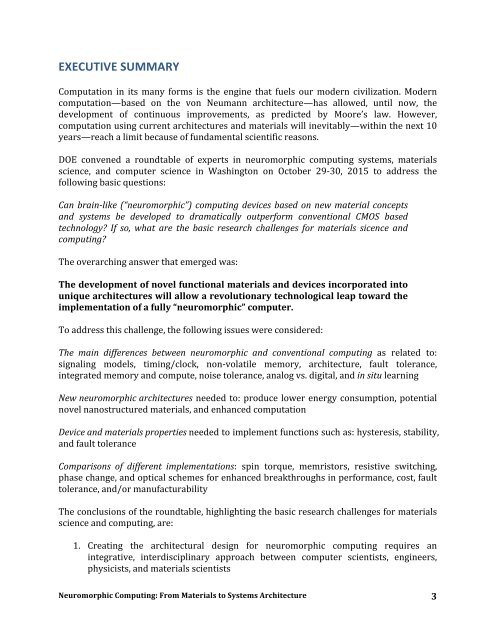Neuromorphic Computing From Materials to Systems Architecture
Neuromorphic-Computing-Report_FNLBLP
Neuromorphic-Computing-Report_FNLBLP
You also want an ePaper? Increase the reach of your titles
YUMPU automatically turns print PDFs into web optimized ePapers that Google loves.
EXECUTIVE SUMMARY <br />
Computation in its many forms is the engine that fuels our modern civilization. Modern <br />
computation—based on the von Neumann architecture—has allowed, until now, the <br />
development of continuous improvements, as predicted by Moore’s law. However, <br />
computation using current architectures and materials will inevitably—within the next 10 <br />
years—reach a limit because of fundamental scientific reasons. <br />
DOE convened a roundtable of experts in neuromorphic computing systems, materials <br />
science, and computer science in Washing<strong>to</strong>n on Oc<strong>to</strong>ber 29-‐‐30, 2015 <strong>to</strong> address the <br />
following basic questions: <br />
Can brain-‐‐like (“neuromorphic”) computing devices based on new material concepts <br />
and systems be developed <strong>to</strong> dramatically outperform conventional CMOS based <br />
technology? If so, what are the basic research challenges for materials sicence and <br />
computing? <br />
The overarching answer that emerged was: <br />
The development of novel functional materials and devices incorporated in<strong>to</strong> <br />
unique architectures will allow a revolutionary technological leap <strong>to</strong>ward the <br />
implementation of a fully “neuromorphic” computer. <br />
To address this challenge, the following issues were considered: <br />
The main differences between neuromorphic and conventional computing as related <strong>to</strong>: <br />
signaling models, timing/clock, non-‐‐volatile memory, architecture, fault <strong>to</strong>lerance, <br />
integrated memory and compute, noise <strong>to</strong>lerance, analog vs. digital, and in situ learning <br />
New neuromorphic architectures needed <strong>to</strong>: produce lower energy consumption, potential <br />
novel nanostructured materials, and enhanced computation <br />
Device and materials properties needed <strong>to</strong> implement functions such as: hysteresis, stability, <br />
and fault <strong>to</strong>lerance <br />
Comparisons of different implementations: spin <strong>to</strong>rque, memris<strong>to</strong>rs, resistive switching, <br />
phase change, and optical schemes for enhanced breakthroughs in performance, cost, fault <br />
<strong>to</strong>lerance, and/or manufacturability <br />
The conclusions of the roundtable, highlighting the basic research challenges for materials <br />
science and computing, are: <br />
1. Creating the architectural design for neuromorphic computing requires an <br />
integrative, interdisciplinary approach between computer scientists, engineers, <br />
physicists, and materials scientists <br />
<strong>Neuromorphic</strong> <strong>Computing</strong>: <strong>From</strong> <strong>Materials</strong> <strong>to</strong> <strong>Systems</strong> <strong>Architecture</strong> <br />
3


